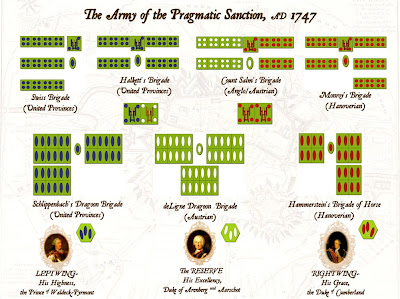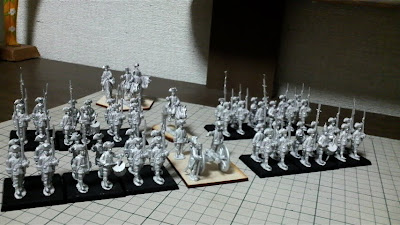Merry Christmas to everyone out there. Hope it is a good one for all.
The plan for world domination- or at least suzerainty over Flanders- continues for the
Army of the Pragmatic Sanction.
As those who know me can attest, I am not a competition gamer and detest tournaments and "rule driven" army lists with matching points.
For one thing, I hate math.
Another thing is that the Gods did not treat everyone so even-handedly in real life out there on the battlefield. Few generals worth their salt would have accepted combat unless they felt reasonably sure that they enjoyed a numerical advantage, or at least some advantage in terrain or supplies. Those that didn't would have had battle forced upon them.
More often than not, the weaker side would retire behind a line of fortresses, where both sides might settle down to a siege and order a fine dinner of venison and claret (after having first arranged for the courtesans to attend them in their camps) until either first one side would pitch tents and return home as winter approached, or the other side would surrender the fortress after asking for- and receiving- the honours of war. Rinse and repeat for the next campaign season.
Still, there are some benefits is having a point system so that initial forces can at least be comparable with one another. After that, and once armies march of to war, things break down, mistakes are made, orders are misunderstood, ignored, or even lost, and roads become impassable. Bluebear Jeff mentioned one of my favourite tabletop devices for ensuring some unexpected "friction", namely dicing for appearance.
Just how many points I'm dealing with here for
Koenig Krieg I need to work out, but Drew on the KK forum suggested that I'm looking at about 1500 points or so. At some point in the future I'll provide a detailed list of the units involved with their stats for use with KK.
*****
I've been tweaking the composition of the army list a little as more snippets of info arise.
First off, it turns out that there
was a mixed Anglo-Austrian Brigade at The Battle of Dettingen, so it stays!
Secondly, I have reconsidered my artillery "doctrine". According to the
Koenig Krieg lists, one army (heavy) gun may be allotted per brigade. So I've decided to do them after all- in large part after seeing some nicely painted batteries in an old issue of
Miniature Wargames that was done by the
League of Augsburg club. These were basically mini-dioramas of heavy guns in action in the Nine-Years War in the 1690's.
I realized that something along the same lines for the War of the Austrian Succession would be fun to do! So, I've added four guns to my target- one each of Austrians, Dutch, British and Hanoverians. The bases won't be quite as big as the one that Phil created, but they will allow me scope for modelling some little extra bits and pieces. Maybe 60-80mm wide by 100mm deep. Just so long as I use the same basing with M. de Saxe's merry men, it should be no problem.
Thirdly, my old bugaboo the Dutch horse. They are always proving themselves to be enigmatic, to say the least. "Seneffe" in his comment on my post on
Dutch Cavalry mentions that Dutch Dragoons could be big regiments, with Schlippenbach's being up to seven(!) squadrons strong.
Things are made complicated by the fact that the army list for the United Provinces that were in the old edition of the
Koenig Krieg rules that I have were clearly based on the reorganized post-WAS Dutch army, so are of no help to me at all. That leaves me with just a few pages on Dutch cavalry in the booklet by Stephen Manley with which to work things out, so Seneffe's help, and that of others, is warmly appreciated.
Anyway, I
may therefore opt for 16-figure instead of 12-figure regiments, but only if I like painting them! I always feel that fielding understrength regiments is always justifiable anyway, as outpost duty, hangovers and glandular fever take their steady toll on numbers.
Finally, we turn to "The Quality"- army commanders. I have included three, not that they will all be in command at the same time. As with all alliances, there was plenty of friction between the different commanders, given touchy caste pride and as a result of frequent contradictory instructions-and pressure- from their respective governments. Not to mention just plain, simple good 'ol incompetence and bloody-mindedness due to gout. There seems to be plenty of opportunities for a "game within a game" to see if subordinates actually
"do as they're dam' well told, damn their eyes, man!" As I'll likely be solo-gaming, this could make the games a lot more interesting.
And if that seems too harsh on the Pragmatic Alliance, just wait until you see my thoughts on the French army with its
boudoir politics and petty jealousies! I'm sure I'll be able to level the playing field. I'm working on an order of battle for the French side now as well, which will appear later this week on my (long-too-inactive)
"les Reves des Mars" site.



















